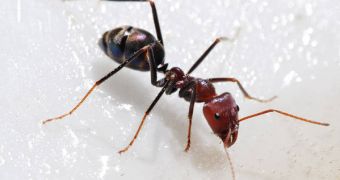For the first time, researchers studying the behavior of the Asian super ant Lasius neglectus have discovered that the small insects seem to have a rather morbid attraction to electrical installations. This liking that the ants have taken in wires, which the experts plastically call the “kamikaze attraction,” may pose significant dangers to households in which ant colonies have set up bases, because short-circuits can always ignite the wires, the installation, and the ants themselves, the BBC News reports. The colonies in the new study have been found in Hidcote Manor, near Chipping Campden, in Gloucestershire, the UK.
These ants, which are not indigenous to Europe, have been brought in by travelers. They are not very widespread in the area, but several sightings of colonies have been made on the mainland. The recent find is believed to be the first recorded evidence that the Asian super ants exist in the UK as well. The reason why they are so dangerous to households is the fact that they have a natural attraction to electricity, and will dig or bite their way through it under all conditions.
These peculiar insects are highly dependent on aphid honeydew, and have been found to live on numerous tree species. They resemble the common black garden species in aspect, and the difference can only be made visible through scientific analysis. Therefore, to identify a colony as a Lasius neglectus, one requires specialized personnel being present on the spot, which makes accurately identifying the existing colonies around Europe and the UK an extremely cost- and labor-intensive process.
“The behavior of the ants didn't agree with that of any known UK species. Our suspicions were confirmed when samples were sent to the Universitat Autonoma de Barcelona which has been studying major infestations of them in Spain. They look just the same as the common black garden ant, although there will be ten to a hundred times as many of them,” English Heritage Entomologist and Architectural Conservator Brian Ridout said of the insects. According to the expert, more than 35,000 ant carcasses have been discovered inside an electrical junction box at Hidcote.
“Their habit of creating super-colonies means they pose a threat to native species by out-competing them for food and space, and their attraction to electrical circuitry means they could pose a fire risk. Researchers have feared for several years that this species would make it to the UK, and while the Hidcote colony is the first case recorded, it is not clear if it is the first in the UK or indeed that it is the only one. It is very likely the ants are more prolific,” National Trust nature conservation advisor Simon Ford concluded.

 14 DAY TRIAL //
14 DAY TRIAL //